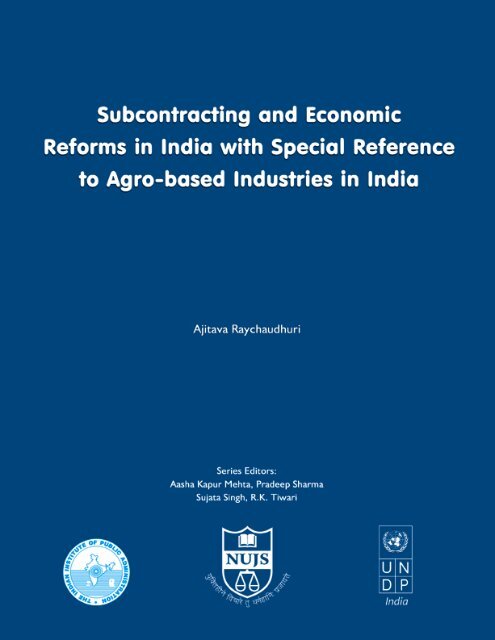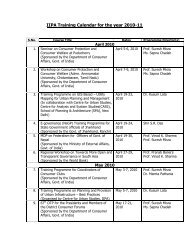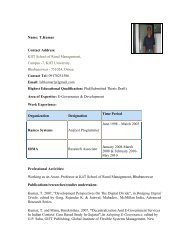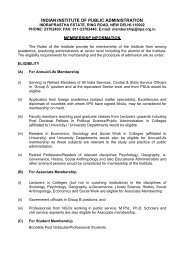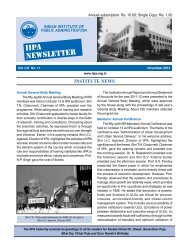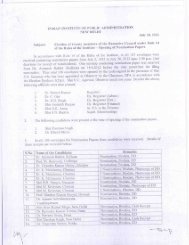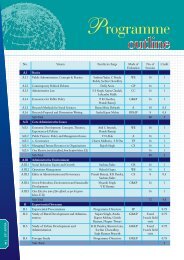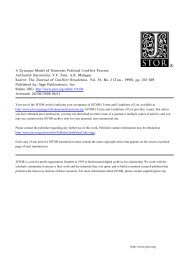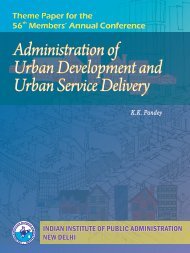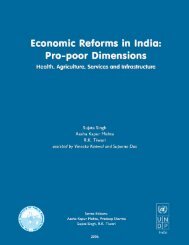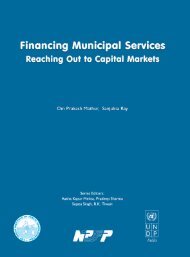Subcontracting and Economic - Indian Institute of Public Administration
Subcontracting and Economic - Indian Institute of Public Administration
Subcontracting and Economic - Indian Institute of Public Administration
You also want an ePaper? Increase the reach of your titles
YUMPU automatically turns print PDFs into web optimized ePapers that Google loves.
<strong>Subcontracting</strong> <strong>and</strong> <strong>Economic</strong><br />
Reforms in India with Special Reference<br />
to Agro-based Industries in India<br />
Ajitava Raychaudhuri<br />
Series Editors:<br />
Aasha Kapur Mehta, Pradeep Sharma<br />
Sujata Singh, R.K.Tiwari<br />
2006
<strong>Economic</strong> Reforms in India: Pro-poor Dimensions<br />
Table <strong>of</strong> Contents<br />
1<br />
2<br />
3<br />
4<br />
5<br />
6<br />
7<br />
8<br />
9<br />
10<br />
11<br />
Introduction 1<br />
What is subcontracting? 3<br />
Different Forms <strong>of</strong> <strong>Subcontracting</strong> 4<br />
The Advantages <strong>of</strong> <strong>Subcontracting</strong> 6<br />
The Disadvantages <strong>of</strong> a <strong>Subcontracting</strong> Relationship 9<br />
Agro-Based Industries in India <strong>and</strong> <strong>Subcontracting</strong> 12<br />
A Theoretical Model <strong>of</strong> <strong>Subcontracting</strong> for High Quality 14<br />
Formulation <strong>of</strong> a Contract Law for Sub-Contracting,<br />
Based on the Theoretical Model 17<br />
Complete <strong>and</strong> Incomplete Contracts 18<br />
Alternative Remedy Measures 19<br />
Damages in Case <strong>of</strong> <strong>Subcontracting</strong> 20<br />
12<br />
Conclusions 22
<strong>Subcontracting</strong> <strong>and</strong> <strong>Economic</strong><br />
Reforms in n India with ith Special Reference<br />
to Agro-based Industries in India<br />
Ajitava Raychaudhuri *<br />
1<br />
Introduction<br />
India embarked upon the path <strong>of</strong> economic liberalisation<br />
from 1991 onwards, although trade sector liberalisation<br />
started in the middle <strong>of</strong> the 1980s (Marjit <strong>and</strong><br />
Raychaudhuri, 1997). One <strong>of</strong> the crucial aspects <strong>of</strong> economic<br />
liberalisation is freeing the industrial sector from<br />
the tyranny <strong>of</strong> industrial licensing for a majority <strong>of</strong> the<br />
industries. The issue <strong>of</strong> subcontracting arises in this context<br />
for two main reasons - one is that large-scale industries<br />
reap the benefits <strong>of</strong> a small permanent labour force<br />
through subcontracting, which helps them to adjust the<br />
fluctuating dem<strong>and</strong> more easily (Raychaudhuri <strong>and</strong><br />
Chatterjee, 1998). Secondly, subcontracting may also<br />
prove to be an opportunity for the small-scale sector to<br />
face global competition through their association with<br />
some large-scale industries, national or foreign. The agrobased<br />
industries play a special role in this since they have<br />
the unique feature <strong>of</strong> relating agriculture <strong>and</strong> industry<br />
simultaneously. On one h<strong>and</strong>, large groups <strong>of</strong> farmers<br />
may be involved <strong>and</strong> on the other, small-scale firms may<br />
be tying up with the large firms in a subcontracting relationship.<br />
This feature is absent for pure industrial goods.<br />
Thus, subcontracting relationships will have a crucial role<br />
for both industry <strong>and</strong> agriculture when the goods concerned<br />
are agro-based in nature.<br />
Going back to the Eighth Five Year Plan document formulated<br />
way back in 1992, there was a suggestion that<br />
large private sector units should be allowed in the food<br />
processing industries since they can create the nucleus<br />
for the proliferation <strong>of</strong> small scale units around these<br />
plants (Eighth Five Year Plan, Volume-2). This clearly<br />
points to the inter-firm relationship envisaged in such a<br />
scenario. All Plan drafts starting from 1992, clearly speak<br />
<strong>of</strong> the urgent need for technology upgradation <strong>and</strong> quality<br />
improvement in the food processing sector, as otherwise,<br />
it is difficult for the sector to compete in international<br />
markets. In this context subcontracting is a mutually<br />
fruitful arrangement, for both the large <strong>and</strong> smallscale<br />
industries.<br />
*<br />
This paper has been published as Working Paper Number – 9, School <strong>of</strong> <strong>Economic</strong> <strong>and</strong> Business Laws, January, 2004. The funding by the West Bengal<br />
National University <strong>of</strong> Juridicial Sciences is gratefully acknowledged. The help provided by two research assistants, specially Simontini Das in collecting the<br />
data, went a long way in completing the study. Background information provided by some companies facilitated in undertaking this study. The views<br />
expressed in this paper are those <strong>of</strong> the author <strong>and</strong> do not necessarily reflect the views <strong>of</strong> GOI, UNDP or IIPA.<br />
1
<strong>Subcontracting</strong> And <strong>Economic</strong> Reforms In India With Special Reference To Agro-based Industries In India<br />
The subcontracting relationships in many industries are informal<br />
arrangements with mutual trust <strong>and</strong> long-term associations<br />
as the major binding principle. However, with<br />
the onset <strong>of</strong> economic reforms <strong>and</strong> the subsequent spread<br />
<strong>of</strong> globalisation, formal arrangements are becoming increasingly<br />
important. This requires a good look at the contract<br />
law <strong>of</strong> India, which has its origins in 1872. Unfortunately,<br />
there is no specific law for subcontracting <strong>and</strong> subcontract<br />
is assumed to be a subset <strong>of</strong> general law <strong>of</strong> contract.<br />
However, subcontract involves more complications<br />
from the point <strong>of</strong> economic theory <strong>and</strong> as such it needs<br />
special clauses to be explicitly addressed in the contract<br />
law.<br />
This paper will discuss the role <strong>of</strong> subcontracting in some<br />
<strong>of</strong> the major industries in India with<br />
implications for the agro-based industries, especially<br />
the food-processing industry. It will also discuss the<br />
law’s effectiveness in solving the moral hazard problems<br />
involved in case <strong>of</strong> subcontracts. The methodology<br />
used is basically borrowed from the industrial<br />
organisation literature as applied to the interface <strong>of</strong><br />
law <strong>and</strong> economics.<br />
2
2<br />
What is <strong>Subcontracting</strong>?<br />
<strong>Subcontracting</strong> is an inter-firm relationship, where a small<br />
firm is either producing different components, intermediate<br />
inputs <strong>and</strong> final output, or providing various assembling<br />
activities, post-selling services, etc. for the parent<br />
firm. The former class <strong>of</strong> firms is generally known<br />
as the subcontractors. At the time <strong>of</strong> placing orders, the<br />
parent firm usually mentions terms <strong>and</strong> conditions regarding<br />
the quality, special characters, designs, delivery<br />
time, financial specifications <strong>and</strong> other details. Often this<br />
outsourcing relation encompasses the risk-sharing arrangement,<br />
technology diffusion mechanism, distinctive<br />
subcontracting control, financial interdependency, etc.<br />
Though subcontracting mainly takes place among firms<br />
having unequal bargaining power, two firms, st<strong>and</strong>ing<br />
on the same bargaining platform may also enter into an<br />
outsourcing relationship. This is a long-term relationship<br />
rather than a myopic phenomenon. It is not always<br />
necessary to maintain the one-to-one correspondence<br />
in the subcontracting relationship. That is why it is quite<br />
natural for one parent firm to have a relation with a<br />
cluster <strong>of</strong> small subcontracting firms <strong>and</strong> a single subcontractor<br />
may have multiple clients.<br />
3
<strong>Subcontracting</strong> And <strong>Economic</strong> Reforms In India With Special Reference To Agro-based Industries In India<br />
3<br />
Different Forms <strong>of</strong> <strong>Subcontracting</strong><br />
The nature <strong>of</strong> the production process determines the form<br />
<strong>of</strong> subcontracting <strong>and</strong> also the extent to which the<br />
outsourcing relation develops in an industry. <strong>Subcontracting</strong><br />
is usually possible in those industries, where the<br />
production process is divisible in different stages or the<br />
final product constitutes several components <strong>and</strong> subassembling<br />
activities.<br />
On the basis <strong>of</strong> the parent firm’s behaviour, subcontracting<br />
can be classified into two broad categories. These are:<br />
• Industrial subcontracting ; <strong>and</strong><br />
• Commercial subcontracting.<br />
These two broad categories can again be classified into<br />
several subcategories, which are discussed below:<br />
Industrial <strong>Subcontracting</strong><br />
In industrial subcontracting, the parent firm purchases<br />
different components, intermediate inputs used in the final<br />
output production, or different types <strong>of</strong> assembling services<br />
from its subcontractors. The different forms <strong>of</strong> industrial<br />
subcontracting, are mentioned below:<br />
(i) Component subcontracting ;<br />
(ii) Activity subcontracting ; <strong>and</strong><br />
(iii) Assembling subcontracting.<br />
Each sub-category is described in detail.<br />
(i) Component subcontracting<br />
Component subcontracting is the most common form<br />
<strong>of</strong> the outsourcing relationship, under which the nuclear firm<br />
purchases different components <strong>and</strong> intermediate inputs<br />
required for the completion <strong>of</strong> the final outputs from the<br />
cluster <strong>of</strong> subcontractors. Component subcontracting is <strong>of</strong>ten<br />
observed in the metal industry (Nagaraj, 1984). In this type<br />
<strong>of</strong> inter-firm relationship, the financial <strong>and</strong> technological<br />
support, quality, lay out, etc. are decided by the parent firms.<br />
Since in the market, the final products are sold under the<br />
nuclear firm’s br<strong>and</strong> name, the principal firm undertakes the<br />
marketing, post-selling services, <strong>and</strong> research <strong>and</strong> development<br />
activities.<br />
(ii) Activity subcontracting<br />
Activity subcontracting generally takes place in those production<br />
processes that can be separated. In activity subcontracting,<br />
the production method is divided into several<br />
stages. The inputs are transformed through a number <strong>of</strong><br />
activities, some <strong>of</strong> which are undertaken by a cluster <strong>of</strong><br />
subcontractors, since due to various technological reasons<br />
those distinct, separate activities cannot be carried out continuously<br />
in the same premises. The parent firm organises<br />
the whole production course <strong>and</strong> sells the final product<br />
under its own br<strong>and</strong> name. This type <strong>of</strong> subcontracting is<br />
usually observed in the <strong>Indian</strong> cotton industry (Nagaraj,<br />
1984).<br />
(iii) Assembling subcontracting<br />
Assembling subcontracting is the service subcontracting,<br />
that is, the principal firm is purchasing different types <strong>of</strong><br />
assembling services from its subcontractors (Nagaraj, 1984).<br />
Mainly the parent firm outsources highly labour-intensive<br />
assembling activities to the small firm, to those who have<br />
4
Different Forms <strong>of</strong> <strong>Subcontracting</strong><br />
access to the vast cheap <strong>and</strong> informal labour market. This<br />
type <strong>of</strong> subcontracting is generally observed in the electrical<br />
<strong>and</strong> electronic industries.<br />
Commercial <strong>Subcontracting</strong><br />
Commercial subcontracting is developed on the basis <strong>of</strong><br />
the commercial interdependency between two business<br />
units. In commercial subcontracting, the parent firm only<br />
executes the marketing, advertising <strong>and</strong> distribution <strong>of</strong> the<br />
product, produced by the subcontractors (Ramaswamy,<br />
1999). In this type <strong>of</strong> inter-firm relationship, the mother<br />
firm may not directly participate in the production process.<br />
Subcontractors usually produce the final output on<br />
the basis <strong>of</strong> the quality <strong>and</strong> design guidelines provided by<br />
the parent firm. Product subcontracting is one type <strong>of</strong><br />
commercial subcontracting.<br />
Product subcontracting<br />
Under this sub-heading, the subcontractors produce the<br />
final products individually; the parent firm only undertakes<br />
the marketing <strong>and</strong> the advertising activities. This type <strong>of</strong><br />
subcontracting is usually observed in industries producing<br />
consumer products <strong>and</strong> durable goods, like food, clothing,<br />
leather products <strong>and</strong> electronic appliances, metal products,<br />
etc. Agro-based industries, especially the food processing<br />
industry falls in this category.<br />
Apart from the above mentioned classifications, subcontracting<br />
can be categorised from the relative position <strong>of</strong><br />
the firms along the production axis. These are:<br />
• Horizontal subcontracting ; <strong>and</strong><br />
• Vertical subcontracting.<br />
In horizontal subcontracting, two interdependent firms<br />
operate on the same horizontal stage <strong>of</strong> the vertical production<br />
process. Vertical subcontracting occurs between<br />
two firms, operating at different stages along the vertical<br />
production axis. There are many advantages in developing<br />
the subcontracting inter-firm relationship. It may be observed<br />
that the specialisation subcontracting is vertical in<br />
nature <strong>and</strong> capacity subcontracting is horizontal<br />
(Ramaswamy, 1999).<br />
5
<strong>Subcontracting</strong> And <strong>Economic</strong> Reforms In India With Special Reference To Agro-based Industries In India<br />
4<br />
The Advantages <strong>of</strong> <strong>Subcontracting</strong><br />
In recent days, subcontracting or outsourcing is very <strong>of</strong>ten<br />
observed in different types <strong>of</strong> industry, including consumer<br />
durables, consumer non-durables <strong>and</strong> also in the capital<br />
goods sector. This section describes the principal reasons<br />
that encourage the evolution <strong>of</strong> the outsourcing relationship.<br />
Specialisation<br />
The basic theoretical reason behind the emergence <strong>of</strong> the<br />
outsourcing relationship, especially in the manufacturing<br />
industry, is the principle <strong>of</strong> division <strong>of</strong> labour <strong>and</strong><br />
specialisation. In the case <strong>of</strong> the divisible production process,<br />
subcontracting may help substantially to achieve economies<br />
<strong>of</strong> scale. It has been observed that new-sprung industries<br />
are more likely to be vertically integrated, that is,<br />
they prefer in-house activities rather than outsourcing. Yet,<br />
as the dem<strong>and</strong> for the product increases, the industries have<br />
a greater tendency to disintegrate the production process<br />
<strong>and</strong> to enter into a subcontracting relationship.<br />
From the above discussion, it can be observed that the<br />
specialisation phenomenon is facilitated by this outsourcing<br />
relationship. Specialisation subcontracting is commonly<br />
observed in Japan <strong>and</strong> North America (Ramaswamy, 1999).<br />
Labour Market Fragmentation<br />
In most <strong>of</strong> the developing economies the labour market is<br />
<strong>of</strong>ten segregated into two components, having opposite<br />
characteristics - organised labour market <strong>and</strong> unorganised<br />
labour market. In the organised labour market, the<br />
workers are well paid, governed by long-term contracts,<br />
subject to government regulations <strong>and</strong> trade union pressure.<br />
On the other h<strong>and</strong>, workers in the unorganised labour<br />
market, are low paid. There is no job security, nor pressure<br />
<strong>of</strong> trade union <strong>and</strong> government regulations on the health<br />
<strong>and</strong> safety <strong>of</strong> the employees. The unorganised sector is<br />
completely outside government patronage.<br />
This binary character <strong>of</strong> the labour market <strong>of</strong>ten encourages<br />
product subcontracting as well as employment subcontracting.<br />
The large unionised firms can utilise this vast<br />
informal labour market indirectly by giving the subcontract<br />
to a cluster <strong>of</strong> small firms, who have access to the<br />
unprotected labour supply at a cheap rate. The problem<br />
<strong>of</strong> the informal sector or the small firms is an insufficient<br />
supply <strong>of</strong> capital. The nuclear firm usually provides the<br />
technology <strong>and</strong> finance to the subcontractors. This<br />
outsourcing helps the principal firm to reduce its overhead<br />
costs <strong>and</strong> the bargaining power <strong>of</strong> the union. According<br />
to Deshp<strong>and</strong>e (1997), the trade unions noticed<br />
that their bargaining power has a negative correlation with<br />
the availability <strong>of</strong> the outsourcing relation to the management.<br />
In fact, Ramaswamy (1999) has also mentioned that<br />
some unorganised, but high wage business units may increase<br />
pr<strong>of</strong>it by farming out certain labour-intensive peripheral<br />
activities. <strong>Subcontracting</strong>, emerging due to the fragmented<br />
nature <strong>of</strong> the labour market is seen in the <strong>Indian</strong><br />
garment, shoe <strong>and</strong> electrical fan industries <strong>and</strong> in Japan.<br />
6
The Advantages <strong>of</strong> <strong>Subcontracting</strong><br />
Flexibility Relating to the Dem<strong>and</strong><br />
Uncertainty <strong>and</strong> Business Strategy<br />
Today, many industries may face dem<strong>and</strong> uncertainty due<br />
to cyclical <strong>and</strong> seasonal fluctuation. In such situations, a<br />
large firm may use outsourcing to exp<strong>and</strong> its capacity<br />
without increasing its permanent <strong>and</strong> regular employment<br />
level <strong>and</strong> infrastructure. Here farming out is preferred to<br />
in-house activity, since in-house production increases the<br />
permanent costs even during recession.<br />
The small peripheral firms are used as the buffer stock. In<br />
most cases, the relationships between the parent firm <strong>and</strong><br />
the ancillaries are not equal. So the parent firm can easily<br />
transfer the burden <strong>of</strong> the market fluctuation to its peripheral<br />
firms by delaying payment or by refusing to take delivery<br />
<strong>of</strong> the goods or by postponing inspection <strong>of</strong> the<br />
material. Moreover, the workers <strong>of</strong> the unorganised sector<br />
are less unionised <strong>and</strong> have lower bargaining power<br />
compared to the large firms’ workforce. So during the<br />
recession period, it is easier to lay them <strong>of</strong>f rather than the<br />
permanent employees <strong>of</strong> the nuclear firm. This type <strong>of</strong><br />
subcontracting is used in the <strong>Indian</strong> garment <strong>and</strong> electrical<br />
industries.<br />
Transaction Cost<br />
According to Coase <strong>and</strong> Williamson, one important<br />
concern <strong>of</strong> the firm is to design the production process in<br />
such a way that transaction cost is minimised. The<br />
transaction cost is the cost relating to the transactional<br />
environment, which includes relation-specific assets <strong>and</strong> cost<br />
due to poor labour relations, etc. There are also other types<br />
<strong>of</strong> transaction costs. If the transaction cost related to inhouse<br />
production is very high, then subcontracting can act<br />
as a device to reduce the high transaction costs (Kimura,<br />
2001).<br />
Usually infant industries, facing high contracting costs,<br />
prefer the vertically integrated production process, but<br />
once the industry matures <strong>and</strong> the products<br />
are st<strong>and</strong>ardised, the firm would like the outsourcing<br />
relation.<br />
Long Ter<br />
erm Relation on the Basis <strong>of</strong><br />
Game Theory Approach<br />
The subcontracting relationship can be explained by using<br />
the game theoretic approach. It can be shown that a longterm<br />
co-operative relation between a principal firm <strong>and</strong><br />
subcontractors can be developed on the basis <strong>of</strong> the repeated<br />
game theory <strong>and</strong> reputation facet. So a successful<br />
farming-out relation can be formed if there is repeated<br />
interaction between principal firms <strong>and</strong> peripheral units in<br />
the long run (Kimura, 2001).<br />
Information Approach<br />
The theoretical foundation <strong>of</strong> the outsourcing relation can<br />
also be found in the economics <strong>of</strong> information approach.<br />
This approach is based on the contract theory, particularly<br />
the principal-agent model in which long-term relationships<br />
work for fostering efficient risk sharing arrangements under<br />
incomplete information (Kimura, 2001). The information<br />
approach describes the logic <strong>of</strong> saving monitoring<br />
costs, which partially explains why subcontracting is chosen<br />
instead <strong>of</strong> purchasing in the spot market.<br />
Network Approach<br />
The network approach advocates that the subcontracting<br />
relation is an intermediate organisation in which the market<br />
principal coexists. Under a particular economic environment,<br />
an outsourcing relationship with an efficient combination<br />
<strong>of</strong> competition <strong>and</strong> co-ordination is formed<br />
(Kimura, 2001). The network approach suggests that subcontracting,<br />
rather than vertical integration, is chosen when<br />
upstream production requires specialised technology or uses<br />
a particular productive factor such as specialised machines<br />
or unskilled labour in the secondary labour market.<br />
7
<strong>Subcontracting</strong> And <strong>Economic</strong> Reforms In India With Special Reference To Agro-based Industries In India<br />
State Policy<br />
Sometimes different government policies encourage subcontracting<br />
relationships. In the case <strong>of</strong> the <strong>Indian</strong> economy,<br />
an outsourcing relationship can take full advantage <strong>of</strong> the<br />
dual state policies. There are two types <strong>of</strong> policies affecting<br />
the development <strong>of</strong> the farming-out relationship. One<br />
<strong>of</strong> them is the positive measure <strong>of</strong> promoting small-scale<br />
industries through product reservations, concessional credit<br />
for fixed <strong>and</strong> working capital <strong>and</strong> fiscal incentives. A large<br />
number <strong>of</strong> products are reserved exclusively for smallscale<br />
producers <strong>and</strong> large business units are not allowed to<br />
enter into those product lines. The small-scale sector is not<br />
subject to capacity licensing. Exemption from payment <strong>of</strong><br />
excise tax has been the most attractive fiscal incentive for<br />
small firms. The value <strong>of</strong> this incentive scheme is found to<br />
be very high, as rates <strong>of</strong> duty vary from 15 percent to 105<br />
percent.<br />
The second strategy is the protective measure to restrict the<br />
growth <strong>of</strong> large business units. The MRTP Act (Monopolies<br />
<strong>and</strong> Restrictive Trade Practices Act), <strong>and</strong> FERA (Foreign<br />
Exchange Regulation Act) put restrictions on the expansion<br />
<strong>of</strong> large firms. The second policy forces the large firms<br />
with frozen capacities to outsource additional output. The<br />
first policy facilitates outsourcing by creating a small-scale<br />
sector capable <strong>of</strong> producing numerous intermediate <strong>and</strong><br />
final products with simple technology. Small firms usually<br />
obtain the technology from their customer firms <strong>and</strong> equipment<br />
suppliers. So a subcontracting relationship gives them<br />
an opportunity to acquire technical skills <strong>and</strong> managerial capabilities<br />
(Ramaswamy, 1999).<br />
8
5<br />
The Disadvantages <strong>of</strong> a<br />
<strong>Subcontracting</strong> Relationship<br />
Though the outsourcing relationship provides flexibility,<br />
diversification <strong>of</strong> risk <strong>and</strong> uncertainty regarding market<br />
dem<strong>and</strong>, opportunities for reducing the labour cost <strong>and</strong><br />
fixed overhead costs, this sort <strong>of</strong> relationship has some<br />
major disadvantages. Some <strong>of</strong> these adversely affect the<br />
principal firms; some others hit the interests <strong>of</strong> the subcontractors.<br />
The problems associated with the development<br />
<strong>of</strong> the outsourcing relation, can generally be classified<br />
into two broad categories-<br />
1. Problems faced by the principal firms.<br />
2. Problem faced by the cluster <strong>of</strong> ancillaries.<br />
1. Problems Faced by the Principal<br />
Firms<br />
The major difficulties faced by the parent business unit<br />
entering in an outsourcing relationship are:<br />
• Deterioration <strong>of</strong> the product quality.<br />
• Hindrances in the expansion <strong>of</strong> the scale <strong>of</strong> production.<br />
• Failure in delivering the product within the stipulated<br />
time.<br />
• High monitoring cost, avoidance <strong>of</strong> which leads to<br />
the moral hazard problem .<br />
These problems, however, are interdependent. Each <strong>of</strong><br />
them is discussed below.<br />
Deterioration <strong>of</strong> the product quality<br />
In recent decades, globalisation has put more stress on nonprice<br />
competition - mainly on the upgradation <strong>of</strong> quality<br />
(Marjit <strong>and</strong> Raychaudhuri, 1997). It is <strong>of</strong>ten observed that<br />
this farming-out relationship leads to poor quality <strong>of</strong> final<br />
output (Raychaudhuri <strong>and</strong> Chatterjee, 1998). In the case <strong>of</strong><br />
vertical subcontracting, the disintegration <strong>of</strong> the production<br />
process <strong>and</strong> poor quality goods <strong>and</strong> services, at the<br />
initial stages, leads to deterioration in the quality <strong>of</strong> the<br />
product at the final stages. On the other h<strong>and</strong>, horizontal<br />
subcontracting <strong>of</strong>ten gives rise to a heterogeneous package<br />
<strong>of</strong> final output with a high degree <strong>of</strong> variability in<br />
quality.<br />
Though the above discussion establishes the fact that<br />
outsourcing could result in quality degradation, recent studies<br />
point out that entrepreneurial myopic vision, rather than<br />
the farming-out relation, aggravates the problem<br />
(Raychaudhuri <strong>and</strong> Chatterjee, 1998; Banerjee, 1988). This<br />
type <strong>of</strong> problem is commonly observed in the garment<br />
<strong>and</strong> electrical industries <strong>of</strong> West Bengal.<br />
Hindrances in the expansion <strong>of</strong> the scale <strong>of</strong><br />
production<br />
As the outsourcing activities give the chance to exp<strong>and</strong><br />
output without augmenting the production infrastructure<br />
<strong>and</strong> employment level, sometimes the inter-firm relationships<br />
restrict the expansion <strong>of</strong> the scale <strong>of</strong> production.<br />
9
<strong>Subcontracting</strong> And <strong>Economic</strong> Reforms In India With Special Reference To Agro-based Industries In India<br />
In many situations, though expansion <strong>of</strong> production leads<br />
to scale economy, the large business units may continue<br />
to outsource the products to avoid volatility in their own<br />
production due to market uncertainty. This leads to the<br />
inefficient use <strong>of</strong> the factor inputs.<br />
Failure in delivering the product within the stipulated<br />
time<br />
As the intermediate inputs (in case <strong>of</strong> the vertical subcontracting)<br />
<strong>and</strong> final outputs (in case <strong>of</strong> commercial subcontracting),<br />
are physically manufactured by the cluster <strong>of</strong> ancillaries,<br />
delivery time turns out to be a crucial variable. If<br />
the supply <strong>of</strong> any one intermediate input is delayed, then<br />
the completion <strong>of</strong> the final outputs is also delayed, which<br />
may have a negative impact on the principal firm’s reputation.<br />
High monitoring cost, avoidance <strong>of</strong> which leads to<br />
moral hazard problem<br />
As subcontracting activities are executed outside the premises<br />
<strong>of</strong> the principal unit, direct monitoring <strong>of</strong> the production<br />
process is not possible. Quite <strong>of</strong>ten subcontractors<br />
do not undertake proper quality control measures,<br />
which has a negative impact on the quality <strong>of</strong> the final<br />
output. Though sometimes piloting or quality checking is<br />
done by the parent firm, it does not completely overcome<br />
the moral hazard problem. It can only reduce the intensity.<br />
For example, in West Bengal’s electric fan industry, subcontractors<br />
do the painting <strong>of</strong> the electrical parts. Though<br />
the mother firm provides the expensive paint, finance etc.,<br />
the subcontractors <strong>of</strong>ten keep aside a part <strong>of</strong> the expensive<br />
input. This affects the quality <strong>of</strong> the product. At the<br />
time <strong>of</strong> quality checking, this deviation cannot be detected,<br />
but in the long run it reduces the longevity <strong>of</strong> the goods<br />
(Banerjee, 1988).<br />
2. Problems Faced by the Cluster <strong>of</strong><br />
Ancillaries (or the Subcontractors)<br />
Not only the principal firm, but the ancillaries also face<br />
some disadvantages in a subcontracting relationship. The<br />
most common problems suffered by the peripheral firms<br />
are listed below:<br />
• Exploitation <strong>of</strong> the subcontractors.<br />
• Uncertainty.<br />
• Uneven risk sharing.<br />
These difficulties are explained below.<br />
Exploitation <strong>of</strong> the subcontractors<br />
As the core firm <strong>and</strong> the peripheral firms are st<strong>and</strong>ing on<br />
unequal bargaining pedestals, the exploitation <strong>of</strong> the weaker<br />
party is quite possible. In fact, one <strong>of</strong> the economic foundations<br />
<strong>of</strong> the development <strong>of</strong> this inter-firm relationship<br />
is the dual fragmentation <strong>of</strong> the labour market. As the<br />
informal sector, consisting a group <strong>of</strong> small firms, has<br />
access to the large, cheap <strong>and</strong> unorganised labour market,<br />
the large business houses <strong>of</strong>ten show an interest in entering<br />
into an outsourcing relation to utilise this low-cost working<br />
force. There is a huge wage difference between the<br />
employees <strong>of</strong> formal <strong>and</strong> informal sectors. As the workers<br />
in the informal sector are not unionised, they are <strong>of</strong>ten<br />
jobless during the recession period.<br />
This might lead to generation <strong>of</strong> little or no surplus in the<br />
informal sector, resulting in no investment for the<br />
upgradation <strong>of</strong> the existing technology. The whole cluster<br />
<strong>of</strong> subcontractors is confined to a low technology <strong>and</strong><br />
low quality vicious circle. This type <strong>of</strong> problem mainly<br />
occurs in developing countries, like India (Banerjee, 1988).<br />
Uncertainty<br />
A group <strong>of</strong> the subcontracting firms is usually clustered around<br />
a single nuclear firm. In this case, rejection <strong>of</strong> products by the<br />
mother firm leaves them with practically no option to dispose<br />
<strong>of</strong>f their products. This uncertainty is reduced to some<br />
extent, if the ancillary has more than one client.<br />
Uneven risk sharing<br />
One <strong>of</strong> the basic reasons behind the evolution <strong>of</strong> the<br />
outsourcing relationship is the diversification <strong>of</strong> the risk<br />
portfolio, emerging out <strong>of</strong> market uncertainty. Yet, as the<br />
bargaining power <strong>of</strong> the small <strong>and</strong> large firms differs,<br />
10
The Disadvantages <strong>of</strong> a <strong>Subcontracting</strong> Relationship<br />
the risk sharing is also uneven, tilted more towards the small<br />
firms. So, any type <strong>of</strong> market shock affects the subcontractors<br />
first. Though the complementary association provides<br />
the basis <strong>of</strong> the outsourcing relation, the knowledge level,<br />
technological upgradation or the availability <strong>of</strong> the financial<br />
capital are different for the principal firm <strong>and</strong> the subcontractor<br />
firms. Often the principal firm rejects the product<br />
lot. In such a situation, the subcontractors have to bear the<br />
total loss. This type <strong>of</strong> exploitation can be reduced if the<br />
subcontractor has multiple clients. If the subcontractors<br />
recognise their collective bargaining strength, they can<br />
negotiate with the parent firms. But in the presence <strong>of</strong><br />
huge unemployment, there remains a possibility that anybody<br />
can undercut the cooperation (Banerjee, 1988).<br />
11
<strong>Subcontracting</strong> And <strong>Economic</strong> Reforms In India With Special Reference To Agro-based Industries In India<br />
6<br />
Agro-Based Industries in India<br />
<strong>and</strong> <strong>Subcontracting</strong><br />
<strong>Subcontracting</strong> in the agro-based industries in India did<br />
not develop as fast as some other industries. This is fairly<br />
consistent with some other countries like Japan where,<br />
in the 1990s, less than 15 percent <strong>of</strong> agro-based industries<br />
went for subcontracting (Kimura, 2001). However,<br />
in India, there are tremendous possibilities for developing<br />
important subcontracting relationships in the burgeoning<br />
agro-based industries, especially in the foodprocessing<br />
industries segment. The following data, taken<br />
from indiainfoline (http://www.indiainfoline.com) database,<br />
gives a comprehensive view <strong>of</strong> agro-based industries<br />
in India.<br />
• India is among the world’s major producers <strong>of</strong> food,<br />
producing over 600 million tonnes <strong>of</strong> food products<br />
every year.<br />
• India’s share in international food trade is a minuscule<br />
1.5 percent. Value addition to foods by<br />
processing is a mere 8 percent <strong>of</strong> the total<br />
production.<br />
• A majority <strong>of</strong> the food units are occupied in primary<br />
processing. The production base <strong>of</strong> secondary <strong>and</strong><br />
tertiary processed foods is low, resulting in low value<br />
addition.<br />
• The Ministry <strong>of</strong> Food Processing estimates the size <strong>of</strong><br />
the processed food industry at Rs. 1440 billion.<br />
Unorganised, small players (processing less than 0.5<br />
tons per day) process more than 75 percent <strong>of</strong> the<br />
industry output in terms <strong>of</strong> volume <strong>and</strong> 50 percent<br />
in terms <strong>of</strong> value.<br />
• The processed food industry ranks fifth in size in the<br />
country representing 6.3 percent <strong>of</strong> the GDP, accounts<br />
for 13 percent <strong>of</strong> the country’s exports <strong>and</strong> involves 6<br />
percent <strong>of</strong> total industrial investment in the country.<br />
• The industry employs 1.6 million workers, who constitute<br />
18 percent <strong>of</strong> the country’s industrial labour<br />
force.<br />
• Processed food exports were Rs 48.95 billion (US$<br />
1.04 billion) in 2000-01, registering a 23 percent decline<br />
over the previous year.<br />
• There are very few large <strong>Indian</strong> food br<strong>and</strong>s with an<br />
established global presence. Most exports are in bulk<br />
form <strong>and</strong> br<strong>and</strong>ing is minimal.<br />
• The packaged foods industry, consisting <strong>of</strong> semiprocessed<br />
<strong>and</strong> ready-to-eat/packaged food is estimated<br />
to be close to Rs 40 billion, <strong>and</strong> is growing<br />
at a fast pace.<br />
• Since liberalisation in August 1991, upto December<br />
2000, 6427 proposals for projects <strong>of</strong> over Rs. 538<br />
billion (US$ 11.4 billion) have been received from various<br />
segments <strong>of</strong> the food <strong>and</strong> agro-processing industry.<br />
Besides this, the government has also approved<br />
12
Agro-Based Industries in India <strong>and</strong> <strong>Subcontracting</strong><br />
1135 proposals for joint ventures; foreign collaboration,<br />
industrial licenses <strong>and</strong> 100 percent export oriented<br />
units envisaging an investment <strong>of</strong> Rs 194 billion (US $<br />
4.1 billion).<br />
• Foreign investment in the sector has been comp<br />
aratively more encouraging with 24 percent <strong>of</strong> the<br />
proposed projects implemented. Total foreign investment<br />
upto December 2000 in the Food Processing<br />
sector has been Rs 26 billion.<br />
Apart from the above facts, one may note the following<br />
as revealed by the Five-Year Plan drafts <strong>of</strong> the Planning<br />
Commission <strong>of</strong> India:<br />
• India is now the largest producer <strong>of</strong> milk.<br />
• India is the second largest producer <strong>of</strong> fruits <strong>and</strong><br />
vegetables.<br />
• In India, only 2 percent <strong>of</strong> fruits <strong>and</strong> vegetables are<br />
processed as opposed to 80 percent in Brazil, 80 percent<br />
in Philippines, 83 percent in Malaysia <strong>and</strong> 30 percent<br />
in Thail<strong>and</strong>.<br />
• In 1996, only 35 percent <strong>of</strong> installed capacity was<br />
utilised in the food-processing industry, mainly due<br />
to a narrow product base, technological obsolescence,<br />
high cost <strong>and</strong> poor quality <strong>of</strong> raw materials.<br />
• The bakery sector is the largest sector <strong>of</strong> the processed<br />
food industry, although in 1996, per capita consumption<br />
<strong>of</strong> bread in India was 1.4 kilograms a year compared<br />
to 25 kilograms in USA.<br />
• In 1996, the food processing industry contributed 19<br />
percent <strong>of</strong> the industrial GDP, but got only 5.2 percent<br />
<strong>of</strong> total industrial investment.<br />
• The major impediments in the expansion <strong>of</strong> the food<br />
processing industry are lack <strong>of</strong> good quality <strong>and</strong> hygienic<br />
raw materials, poor technology, low investment<br />
<strong>and</strong> absence <strong>of</strong> large industries.<br />
The above description makes it clear that among the agrobased<br />
industries, the food-processing industry has a huge<br />
potential for development. <strong>Subcontracting</strong> in food-processing<br />
industries can be successful provided large firms<br />
enter this sector <strong>and</strong> develop a cluster <strong>of</strong> small firms around<br />
them. The small firms are in a better position to get the<br />
raw materials from the farmers <strong>and</strong> bring them to the<br />
production location. This saves transaction costs in terms<br />
<strong>of</strong> distance, time <strong>and</strong> monitoring. Some large firms in India<br />
have started production through a network <strong>of</strong> small<br />
firms. Mention may be made <strong>of</strong> ITC Agro, Dabur,<br />
Hindustan Lever <strong>and</strong> Nestle. The first one has entered the<br />
processed wheat, ready-to-eat meals <strong>and</strong> bakery segments,<br />
while Dabur has entered the processed fruit drink segment.<br />
Hindustan Lever has captured a large part <strong>of</strong> the<br />
jam <strong>and</strong> jelly segment <strong>of</strong> the <strong>Indian</strong> market. Nestle is doing<br />
good business in pasta <strong>and</strong> sauce products.<br />
In order for the subcontracting relationship to succeed in<br />
the food-processing segment, one must have a clear idea<br />
about two aspects <strong>of</strong> subcontracting, namely:<br />
1. Theoretical underpinning <strong>of</strong> having a successful subcontracting<br />
relationship; <strong>and</strong><br />
2. The need to incorporate changes in the existing laws<br />
<strong>of</strong> contract to accommodate subcontracting.<br />
13
<strong>Subcontracting</strong> And <strong>Economic</strong> Reforms In India With Special Reference To Agro-based Industries In India<br />
7<br />
A Theoretical Model <strong>of</strong><br />
<strong>Subcontracting</strong> for High Quality<br />
The following is a model applicable to a new processed<br />
food introduced under monopoly. Although some modifications<br />
are needed to fit it in the monopolistic competition<br />
models, which may be prevalent for some food<br />
products, the essence <strong>of</strong> the story does not change.<br />
Chatterjee <strong>and</strong> Raychaudhuri (2000) originally proposed<br />
this type <strong>of</strong> a model.<br />
The Model<br />
In this model we try to find whether it is possible for the<br />
parent monopoly large firm to maintain the quality level<br />
<strong>of</strong> the final product in the industry with subcontracting.<br />
We assume that a monopolist is bringing a new product<br />
into the market <strong>and</strong> that the product is a non-durable<br />
processed food commodity. The production process is<br />
subdivided into two stages. <strong>Subcontracting</strong> small firms<br />
undertake the first stage <strong>of</strong> the production process. In<br />
the second stage, the monopolist finishes the product<br />
<strong>and</strong> supplies it to the market.<br />
It is assumed that quality level <strong>of</strong> the final product is<br />
determined by the quality <strong>of</strong> the unfinished product<br />
supplied by the subcontractors to the monopolist. The<br />
monopolist only finishes the product <strong>and</strong> supplies it to<br />
the market. The contractor can supply a high or low<br />
quality product.<br />
In this paper, we assume that the monopolist has no<br />
information about the product quality served by the sub-<br />
contractors, thus the quality level <strong>of</strong> the final product is<br />
also unknown to him. In this case we consider that there<br />
are two periods. The consumers can infer about the quality<br />
<strong>of</strong> the product at the end <strong>of</strong> the first period. In the<br />
second period, the product quality is common knowledge.<br />
The product becomes obsolete at the end <strong>of</strong> the<br />
second period. We assume that in the first period, consumers<br />
form an expectation about the quality <strong>of</strong> the product<br />
supplied by the monopolist <strong>and</strong> this expectation is<br />
formed exogenously (Metrick <strong>and</strong> Zeckhauser, 1996).<br />
Given these assumptions, we try to find the incentives<br />
scheme, which will induce the agent firms to produce a<br />
high quality product, whereby the monopolist can continue<br />
to exist in the market in the second period.<br />
We assume that a monopolist is facing a continuum <strong>of</strong><br />
consumers with the index <strong>of</strong> willingness to pay defined<br />
by the variable θ, where θ is distributed uniformly over<br />
the range [ θ, θ]<br />
with unit density. We define ‘q’ as the quality<br />
level <strong>of</strong> the final product, where ‘q’ can assume two different<br />
values q h<br />
<strong>and</strong> q l<br />
where q h<br />
> q l<br />
. It is assumed that a<br />
representative consumer considers that the quality <strong>of</strong> the<br />
product is high with probability µ. This probability is independent<br />
<strong>of</strong> firm’s pricing decision that is, µ is exogenously<br />
given. In the first period the consumer expects that a firm<br />
will supply quality level ‘ ’ where<br />
q = µq h<br />
+(1-µ) q l<br />
q h<br />
>q l<br />
-------------------------- 1<br />
It is assumed that consumers will infer about the quality<br />
14
A Theoretical Model <strong>of</strong> <strong>Subcontracting</strong> for High Quality<br />
perfectly at the end <strong>of</strong> the first period <strong>and</strong> they will purchase<br />
the product again if the quality is high, that is, q=q h<br />
.<br />
It is assumed that the product becomes obsolete at the<br />
end <strong>of</strong> the second period. The utility function <strong>of</strong> an individual<br />
is defined as<br />
}<br />
u =θq - p If consumer purchases one unit <strong>of</strong><br />
product with quality q <strong>and</strong> price p 2<br />
=0 Otherwise<br />
Assume p 1<br />
<strong>and</strong> p 2<br />
be the prices charged by the monopolist<br />
in periods 1 <strong>and</strong> 2 respectively <strong>and</strong> x 1<br />
<strong>and</strong> x 2<br />
are the corresponding<br />
dem<strong>and</strong>s.<br />
p<br />
Thus x 1<br />
= 1<br />
p θ − <strong>and</strong> x 2<br />
= θ − 2<br />
for q=q h<br />
in previous<br />
q qh<br />
<strong>and</strong> current period <strong>and</strong> x 2<br />
= 0 otherwise.<br />
In this case the subcontractor undertakes the first stage <strong>of</strong><br />
production <strong>of</strong> each unit <strong>of</strong> output <strong>and</strong> the quality level is<br />
determined at this stage <strong>of</strong> production. However, the<br />
monopolist cannot observe the quality level supplied by<br />
the subcontractor. In the second stage <strong>of</strong> production, the<br />
monopolist finishes the product <strong>and</strong> supplies it to the market.<br />
Let ‘c’ be the monopolist’s per unit finishing cost <strong>of</strong><br />
the product. It is assumed that ‘c’ is constant <strong>and</strong> independent<br />
<strong>of</strong> the level <strong>of</strong> output <strong>and</strong> quality level <strong>of</strong> the product.<br />
It is assumed that there are a large number <strong>of</strong> identical<br />
competitive contractors <strong>and</strong> each can produce one unit <strong>of</strong><br />
output in a particular period. Each subcontractor maximises<br />
the present value <strong>of</strong> his two periods’ incomes. Let `π’ be<br />
the income that a contractor in each period gets from his<br />
alternative source <strong>of</strong> employment. If he works under the<br />
monopolist, he earns income r 1<br />
per unit <strong>of</strong> output in the<br />
first period. If he produces high quality goods his unit cost<br />
<strong>of</strong> production is c h<br />
<strong>and</strong> if he produces low quality product,<br />
his unit cost <strong>of</strong> production is c l<br />
where c h<br />
>c l<br />
. If the<br />
subcontractor produces a high quality product in the first<br />
period only then does the monopolist give the contract in<br />
the second period <strong>and</strong> pays r 2<br />
per unit <strong>of</strong> output produced,<br />
to the subcontractor. It is further assumed that subcontractors<br />
make their quality decision in the first period<br />
only 1 . The subcontractor will accept the <strong>of</strong>fer <strong>of</strong> the<br />
monopolist <strong>and</strong> produce a high quality product if <strong>and</strong> only<br />
if the present value <strong>of</strong> his two periods’ income is at least<br />
as great as the present value <strong>of</strong> his income from alternative<br />
source <strong>of</strong> employment, that is, if<br />
_________________3.<br />
This is the individual rationality or reservation constraint<br />
(IR) <strong>of</strong> a subcontractor. Here δ is the discount factor. A<br />
subcontractor will actually produce high quality if <strong>and</strong><br />
only if his earnings from producing low quality goods is<br />
less than what he gets by producing high quality goods,<br />
that is, if<br />
or<br />
____________4.<br />
This is the incentive compatibility constraint (IC). It is assumed<br />
that the monopolist first announces r 1<br />
<strong>and</strong> r 2<br />
. If<br />
contractors accept the <strong>of</strong>fer, they supply the product to<br />
the firm. Given the dem<strong>and</strong> function, <strong>and</strong> r 1<br />
, in the first<br />
period the monopolist maximises his pr<strong>of</strong>it to determine<br />
his price p 1<br />
. If the final product is a high quality one in the<br />
second period, the monopolist will give the contract to the<br />
subcontractor again. The subcontractor will supply the<br />
product <strong>and</strong> receive r 2<br />
in the second period. In the second<br />
period, quality is common knowledge. Given r 2<br />
<strong>and</strong> p 1<br />
,<br />
the monopolist determines p 2<br />
<strong>and</strong> p 2<br />
is equal to full information<br />
monopoly price.<br />
However, if quality supplied at the initial period is poor,<br />
the monopolist faces zero dem<strong>and</strong> in the second period.<br />
Thus, the monopolist’s pr<strong>of</strong>it when high quality is supplied<br />
in the first period is given as<br />
---------------- 5<br />
In this case the monopolist is dealing with a large number<br />
<strong>of</strong> identical agents. It is a two-period model. So he cannot<br />
employ new agents in the second period, because the new<br />
agent will supply a low quality product. There are two<br />
reasons for this situation. Firstly there is no future <strong>and</strong> secondly<br />
the monopolist cannot observe the quality level served<br />
1<br />
If a contractor firm takes quality decision in each period then in the last period, that is, in the second period he will obviously cheat, as there is no future.<br />
15
<strong>Subcontracting</strong> And <strong>Economic</strong> Reforms In India With Special Reference To Agro-based Industries In India<br />
by the contracting firms. For this reason the monopolist<br />
faces a sales constraint in the second period. The size <strong>of</strong><br />
the second period dem<strong>and</strong> must be equal to the size <strong>of</strong><br />
the first period dem<strong>and</strong> as in this case, the size <strong>of</strong> dem<strong>and</strong><br />
is equal to the number <strong>of</strong> agents employed. Thus, while<br />
determining the product’s price, the monopolist faces the<br />
additional constraint that the size <strong>of</strong> dem<strong>and</strong> in both periods<br />
must be equal.<br />
After solving the pr<strong>of</strong>it maximisation <strong>of</strong> the monopolist<br />
subject to IR <strong>and</strong> IC constraints, the maximum pr<strong>of</strong>it <strong>of</strong><br />
the monopolist is given as,<br />
- 6<br />
In this case incentive compatibility constraint is not binding.<br />
In this two-period framework, due to imperfect information,<br />
the monopolist will employ the same set <strong>of</strong><br />
agents in both periods. So, to induce them to produce a<br />
high quality product for both periods, the monopolist<br />
has to <strong>of</strong>fer an excessively high value <strong>of</strong> r 2,<br />
which is more<br />
than enough to induce agent firms to produce a high<br />
quality product. So we have,<br />
________________7<br />
Given this restriction on r 2<br />
any combinations <strong>of</strong> (r 1<br />
, r 2<br />
) can<br />
be chosen by the monopolist, which will satisfy reservation<br />
constraint as equality. Due to imperfect information,<br />
with a large number <strong>of</strong> agents, the monopolist is facing a<br />
sales constraint in the second period <strong>and</strong> that is leading to<br />
excessive payment in the second period.<br />
However, the monopoly large firm will sign a contract<br />
with the promise <strong>of</strong> such a high payment in the second<br />
period, provided it is the best option for him too. As<br />
shown above, the stylised scheme discussed above leaves<br />
no other option for the monopolist. Hence, we conclude<br />
that when the monopolist’s future pr<strong>of</strong>it depends on the<br />
level <strong>of</strong> quality served in the initial period, the monopolist<br />
will find an incentive scheme for which an agent will actually<br />
supply the high quality product. The major implication<br />
is that the second period’s price per unit <strong>of</strong> product<br />
supplied by the agent should be announced higher than<br />
the minimum required to induce the agents to supply the<br />
high quality product.<br />
16
8<br />
Formulation <strong>of</strong> a Contract Law for<br />
<strong>Subcontracting</strong>, Based on the<br />
Theoretical Model<br />
<strong>Indian</strong> Contract Law was originally formulated in 1872, <strong>and</strong><br />
is still the core law, which governs the contract between two<br />
parties doing lawful business between them. The process <strong>of</strong><br />
subcontracting is <strong>of</strong> more recent origin <strong>and</strong> there is no separate<br />
set <strong>of</strong> laws for subcontracting. The Contract Law is<br />
meant to address the problems <strong>of</strong> subcontracting as well.<br />
However, the <strong>Indian</strong> Contract Law is not comprehensive<br />
enough to tackle the problems mentioned in the theoretical<br />
section mentioned above. Let us first summarise the main<br />
sections <strong>of</strong> the <strong>Indian</strong> Contract Law, 1872 (taken from the<br />
internet site www.saarcnet.com):<br />
1. A contract is an enforceable agreement, where a person<br />
accepts a proposal to perform an act (designated as<br />
promisee) at the desire <strong>of</strong> another person (designated<br />
as promisor) (Preamble <strong>of</strong> <strong>Indian</strong> Contract Act).<br />
2. For the purpose <strong>of</strong> a contract, all agreements are contracts<br />
if they are made by the free consent <strong>of</strong> parties<br />
competent to contract, for a lawful consideration <strong>and</strong><br />
with a lawful object, <strong>and</strong> are not expressly declared void<br />
(Chapter II <strong>of</strong> <strong>Indian</strong> Contract Act).<br />
3. The term Fraud is defined in the following way in the<br />
<strong>Indian</strong> Contract Act (Chapter II, section 17):<br />
(a) The active concealment <strong>of</strong> a fact by one having<br />
knowledge or belief <strong>of</strong> the fact;<br />
(b) A promise made without intention <strong>of</strong> permitting it;<br />
(c) Any other act fitted to deceive; <strong>and</strong><br />
(d) Any such act or omission as the law specially<br />
declares to be fraudulent.<br />
4. A contract is called “contingent contract” if the contract<br />
is dependent on the happening <strong>of</strong> some collateral<br />
event. Such contracts cannot be enforced by law unless<br />
<strong>and</strong> until that event occurs. If the event becomes impossible,<br />
such contracts become void (<strong>Indian</strong> Contract<br />
Act, Chapter III).<br />
5. On the performance obligations, the <strong>Indian</strong> Contract<br />
Act clearly states that parties to the contract must either<br />
perform, or <strong>of</strong>fer to perform unless excused by the<br />
law (<strong>Indian</strong> Contract Act, Chapter IV).<br />
6. Chapter VI <strong>of</strong> the <strong>Indian</strong> Contract Act deals with the<br />
question <strong>of</strong> breach <strong>of</strong> contract. Let us quote two relevant<br />
sections from the Act:<br />
Section 73 - “When a contract has been broken, the party who<br />
suffers by such breach is entitled to receive, from the party who has<br />
broken the contract, compensation for any loss or damage caused to<br />
him thereby, which naturally arose in the usual course <strong>of</strong> things<br />
from such a breach, or which the parties knew, when they made the<br />
contract, to be likely to result from the breach <strong>of</strong> it”.<br />
Section 74 - “When a contract has been broken, if a sum is<br />
named in the contract as the amount to be paid in case <strong>of</strong> such<br />
breach, or if the contract contains any other stipulation by way <strong>of</strong><br />
penalty, the party complaining <strong>of</strong> the breach is entitled, whether or<br />
not actual damage or loss is proved to have been caused thereby, to<br />
receive from the party who has broken contract, reasonable compensation<br />
not exceeding the amount so named or, as the case may<br />
be, the penalty stipulated for”.<br />
17
<strong>Subcontracting</strong> And <strong>Economic</strong> Reforms In India With Special Reference To Agro-based Industries In India<br />
9<br />
Complete <strong>and</strong> Incomplete Contracts<br />
The above contract law for India can only be understood<br />
in the present context if one clearly brings out the distinction<br />
between complete <strong>and</strong> incomplete contracts.<br />
According to Shavell (2003), “A contract will be said to<br />
be completely specified (or simply complete) if the list <strong>of</strong> conditions<br />
on which the actions are based is completely exhaustive,<br />
that is, if the contract provides literally for each <strong>and</strong><br />
every possible condition in some relevant universe <strong>of</strong><br />
conditions” (Shavell, Chapter 13, p.1). The <strong>Indian</strong> Contract<br />
Law is an incomplete contract when it comes to<br />
cases <strong>of</strong> subcontracting. We will discuss specific reasons<br />
later, from the theoretical model detailed out earlier.<br />
Shavell next defines the concept <strong>of</strong> a mutually beneficial<br />
contract: “A contract is said to be mutually beneficial or, in the<br />
language <strong>of</strong> economics, Pareto Efficient, if the contract cannot<br />
be modified so as to raise the well-being – the expected<br />
utility – <strong>of</strong> each <strong>of</strong> the parties to it” (Shavell, Chapter<br />
13, p.2).<br />
The next important question is the desirability <strong>of</strong> enforcement<br />
<strong>of</strong> contracts. Shavell quite rightly mentions the two<br />
most important reasons for such enforcement, namely “A<br />
party might not deliver the promised good or perform the promised<br />
service…..If there is failure to perform even though performance<br />
would be best, because its value exceeds its true cost,<br />
then the value <strong>of</strong> the contractual arrangement is diminished<br />
for the parties. Such reductions in the value <strong>of</strong> contracts can<br />
be avoided if contracts are enforced” (Shavell, Chapter 13,<br />
p.5). The other reason is that “without enforcement, the price<br />
cannot be fixed in advance, which is to say, a price hold up<br />
might occur – a party might bargain opportunistically about the<br />
price <strong>of</strong> a transaction – reducing the value <strong>of</strong> the contract<br />
or discouraging the making <strong>of</strong> it altogether” (Shavell, Chapter<br />
13, p.5).<br />
Theoretical Dimensions <strong>of</strong> Breach<br />
<strong>of</strong> Contract<br />
The <strong>Indian</strong> Contract Act does talk about breach <strong>of</strong><br />
contract <strong>and</strong> the resulting need <strong>of</strong> compensation to the<br />
aggrieved party. However, the Act does not specify in clear<br />
detail the possible theoretical dimensions <strong>of</strong> damages to<br />
be paid when a breach <strong>of</strong> contract occurs. A complete<br />
contract should also specify the rules or formulae to pay<br />
for damages. In such case the damage is sometimes referred<br />
to as liquidated damage, since this is intended to<br />
terminate all the legal obligations <strong>of</strong> the party in breach<br />
(Shavell, Chapter 13, p.9). It is clear that when it comes to<br />
subcontracting, due to the asymmetric nature <strong>of</strong> information,<br />
the contracts are not complete <strong>and</strong> as such the rules<br />
are also not exhaustively specified.<br />
When contracts are incomplete, what could be the best<br />
measure <strong>of</strong> damage, so as to provide maximum incentives<br />
to the party who might suffer? This requires knowledge<br />
about different theoretical measures (which are supported<br />
by economic theory) <strong>of</strong> damage as discussed in<br />
the context <strong>of</strong> contract law.<br />
18
10<br />
Alternative Remedy Measures<br />
Expectation Damages<br />
Cooter <strong>and</strong> Ulen (2000) define expectation damages as<br />
follows: “Damages for breach <strong>of</strong> contract compensate the<br />
promisee for the injury caused by the non-performing<br />
promisor”. The promisee is supposed to gain from the<br />
contract. Common Law tradition br<strong>and</strong>s this as “expectation<br />
damage”. Thus, the expected performance <strong>of</strong> the<br />
promisor is crucial in guaranteeing the gain <strong>of</strong> the promisor.<br />
In our example, the promisor is the subcontracted unit, on<br />
whose expected performance the parent unit earns pr<strong>of</strong>it<br />
from the transaction.<br />
Reliance Damages<br />
The promisee may invest in reliance on the promise <strong>of</strong> the<br />
promisor. Thus, breach <strong>of</strong> contract makes all the investment<br />
made by the investor based upon this reliance irrelevant.<br />
Thus, common law tradition calls damages paid due<br />
to this kind <strong>of</strong> breach as “reliance damage”. This damage<br />
really amounts to the difference in gain between making<br />
the contract <strong>and</strong> no contract (Cooter <strong>and</strong> Ulen, 2000). In<br />
our example, this amounts to the extra gain or pr<strong>of</strong>it that<br />
the parent firm could have made had it relied on the<br />
performance <strong>of</strong> the subcontracted unit.<br />
Opportunity Cost Damages<br />
Making a contract with the promisee excludes the promisee<br />
from entering into a contract with another party. The loss <strong>of</strong><br />
gain due to the lost opportunity should be compensated in<br />
case the promisee breaches the contract. Such damages are<br />
called “opportunity cost damages” (Cooter <strong>and</strong> Ulen, 2000).<br />
Cooter <strong>and</strong> Ullen (2000) have shown, when the court can<br />
measure damages perfectly, expectation damages ³ opportunity<br />
costs damages ³ reliance damages. Expectation damage<br />
is greater than opportunity cost damage, since the contractor<br />
firm must have chosen the best available option in<br />
the first place. The expectation damage is greater than reliance<br />
damage, since there must be some possibility <strong>of</strong><br />
gain in the contract over no contract, so the contract was<br />
signed. It is easy to see why the opportunity cost damage<br />
then will exceed reliance damage, since some contract is<br />
always better than no contract in terms <strong>of</strong> gain in pr<strong>of</strong>it.<br />
However, if the court can measure damages imperfectly,<br />
reliance damage can exceed expectation damage too. This<br />
can happen when the investor has his reputation at stake,<br />
which is essentially subjective in nature, based on the<br />
reliance he had placed on the subcontractor. If the court<br />
does not recognise this subjective damage then the<br />
reliance damage will exceed the court-settled expectation<br />
damage.<br />
19
<strong>Subcontracting</strong> And <strong>Economic</strong> Reforms In India With Special Reference To Agro-based Industries In India<br />
11<br />
Damages in Case <strong>of</strong> <strong>Subcontracting</strong><br />
Among the cases <strong>of</strong> subcontracting, the most important<br />
for our purposes is industrial <strong>and</strong> product subcontracting.<br />
This may be any one <strong>of</strong> the types we have mentioned,<br />
namely component, activity, assembly or product subcontracting.<br />
Here, the thorny issue is the imperfect or asymmetric<br />
knowledge about the quality supplied by the subcontracted<br />
units to the parent firm. This problem will<br />
obviously be more acute in case <strong>of</strong> food-processing, or<br />
agro -based industries, since there are three parties involved<br />
in the process. The subcontracted units or the parent firms<br />
procure the raw materials from the farmers <strong>and</strong> then the<br />
subcontractors produce their output. Hence, there has to<br />
be multi-stage quality checking. In case such checks are not<br />
satisfactory at any stage, the whole process gets upset. It is<br />
assumed in the kind <strong>of</strong> models we have discussed that the<br />
initial quality <strong>of</strong> inputs used by subcontractors is good. In<br />
other words, parent firms may be producing the agricultural<br />
crops on their own farms or the farmers are planting<br />
<strong>and</strong> sowing according to pre-specifications. The<br />
problem starts with the subcontractors. Now there are<br />
two options with the producers - to have quality checks<br />
every time <strong>and</strong> for every unit or to have some incentive<br />
schemes, which will induce the subcontractors to<br />
produce the best. The last option is definitely more cost<br />
effective <strong>and</strong> time saving.<br />
In the theoretical model discussed above, there is no role<br />
<strong>of</strong> the legal system. However, as explained earlier, <strong>Indian</strong><br />
Contract Law is not very informative when asymmetric<br />
information is the basis <strong>of</strong> a contract as in case <strong>of</strong> subcontracting.<br />
The alternative concepts <strong>of</strong> damages clarify the<br />
issues much better when the contracts are not complete<br />
(always true when information is incomplete). Let us see<br />
which type <strong>of</strong> damages can be written in a formal contract<br />
between the principal firm <strong>and</strong> the subcontracted agent.<br />
Since the model is <strong>of</strong> two periods, in case <strong>of</strong> bad quality<br />
supplied by the subcontracted unit, the monopolist loses<br />
his pr<strong>of</strong>it <strong>of</strong> the second period. From equation 3 in the<br />
model, the damage to be paid by the subcontractors to<br />
the monopolist should be the lost pr<strong>of</strong>it in the second period.<br />
And this is, by the solution <strong>of</strong> the model, should be<br />
more than the alternative income <strong>of</strong> each subcontractor.<br />
Thus the expectation damage, when the court has knowledge<br />
about costs <strong>and</strong> prices, but not the quality should be:<br />
D e<br />
= expectation damage<br />
= Equal share <strong>of</strong> the lost pr<strong>of</strong>it <strong>of</strong> the principal firm,<br />
where lost pr<strong>of</strong>it incorporates the high rates <strong>of</strong> prices declared<br />
by the monopolist for the subcontractors.<br />
In this case, since all subcontractors are assumed to be alike,<br />
the expectation damage <strong>and</strong> opportunity cost damage will<br />
be the same. What about reliance damage? In case the contractor<br />
had breached the contract, the parent firm would<br />
have lost its reputation as well as customers in the second<br />
period. Thus, the damage is lost pr<strong>of</strong>it <strong>of</strong> the parent firm<br />
in the second period. So the reliance damage would be<br />
again equal to the expectation damage.<br />
The crux <strong>of</strong> the damage measure is that it is calculated on<br />
the basis <strong>of</strong> incentive compatibility non-binding high prices.<br />
Hence in this example, in case <strong>of</strong> a perfect damage<br />
reward, the court should award the same amount <strong>of</strong><br />
damage under all the alternative definitions. The<br />
asymmetry <strong>of</strong> information about quality requires damage<br />
to be computed not only on differential gain, but also on<br />
20
Damages in Case <strong>of</strong> <strong>Subcontracting</strong><br />
opportunity income <strong>of</strong> the subcontractors. However, in<br />
case <strong>of</strong> imperfect damage (under incomplete contract),<br />
expectation damage may be less than reliance damage as<br />
the court may not go by incentive compatibility nonbinding<br />
prices <strong>and</strong> may look only into reservation<br />
constraint prices.<br />
The problem can be made more complicated if one brings<br />
in the case <strong>of</strong> risk. There, attitudes towards the risk will be<br />
crucial <strong>and</strong> the model has to be recast in terms <strong>of</strong> expectations.<br />
This poses additional problems. The important point<br />
which must be stressed is that it is not uncertainty which is<br />
the key to the calculation <strong>of</strong> damage measure, it is the asymmetry<br />
<strong>of</strong> information about quality, which creates the problem.<br />
It is only the subcontractor who has the sole knowledge<br />
about quality <strong>of</strong> inputs supplied. Neither the parent<br />
firm nor the court knows the true quality, since the good<br />
has to be consumed to underst<strong>and</strong> its true quality. The<br />
purpose <strong>of</strong> the contract is to do what the incentive mechanism<br />
is supposed to do. It acts as a proxy for the actions<br />
<strong>of</strong> the principal firm, which satisfies the incentive compatibility<br />
<strong>of</strong> the subcontractors <strong>and</strong> ensures high quality on its<br />
part. The existing contract law should thus be suitably<br />
modified to specify damages in case <strong>of</strong> incomplete contracts<br />
in cases <strong>of</strong> subcontracting.<br />
21
<strong>Subcontracting</strong> And <strong>Economic</strong> Reforms In India With Special Reference To Agro-based Industries In India<br />
12<br />
Conclusions<br />
India is undergoing a rapid phase <strong>of</strong> liberalisation <strong>and</strong><br />
economic reforms. The industrial sector is facing new<br />
challenges <strong>and</strong> within this agro-based industries have<br />
tremendous potential since the latter have not been exploited<br />
properly. One <strong>of</strong> the major characteristics <strong>of</strong><br />
the <strong>Indian</strong> industrial production scenario is the prevalence<br />
<strong>of</strong> subcontracting, which has flourished for several<br />
reasons. One is to avoid the burden <strong>of</strong> fixed overhead<br />
costs <strong>and</strong> the other is to avoid the risk <strong>of</strong> labour<br />
trouble <strong>and</strong> fluctuating dem<strong>and</strong>. Since the agro-based<br />
industries, especially the food-processing sector might<br />
flourish under a similar type <strong>of</strong> subcontract system, the<br />
paper looks into the problem <strong>of</strong> moral hazards associated<br />
with subcontracting in general. The main outcome<br />
<strong>of</strong> the moral hazard problem is its adverse impact on<br />
the quality <strong>of</strong> the products, which starts from production<br />
to delivery <strong>and</strong> after sales services. This raises the<br />
issue <strong>of</strong> what could be done to solve the problem. In<br />
this context, a preliminary exercise is done regarding how<br />
the <strong>Indian</strong> Contract Act may be suitably enlarged <strong>and</strong><br />
modified to tackle the question <strong>of</strong> moral hazard associated<br />
with the process <strong>of</strong> subcontracting.<br />
22
References<br />
Banerjee, N. 1988. ‘Small <strong>and</strong> Large Units: Symbiosis or<br />
Matsyanyaya’ in Suri, G.K. (ed) Small Scale Enterprises in<br />
Industrial , Sage <strong>Public</strong>ations, New Delhi.<br />
Bhavani, T.A. 2002. ‘Small Scale Units In The Era Of<br />
Globalisation: Problems <strong>and</strong> Prospects’, <strong>Economic</strong><br />
<strong>and</strong> Political Weekly, July.<br />
Chatterjee, Tanmoyee <strong>and</strong> Raychaudhuri, A. 2000.<br />
‘<strong>Subcontracting</strong> <strong>and</strong> Product Quality’, DSA Centre for<br />
Regional <strong>Economic</strong> Studies, Working Paper Series 2000-<br />
01, #3, Department <strong>of</strong> <strong>Economic</strong>s, Jadavpur University,<br />
Calcutta.<br />
Cooter, R. <strong>and</strong> Ullen, T. 2000. Law <strong>and</strong> <strong>Economic</strong>s, 3 rd Edition,<br />
Reading, Mass: Addision Wesley Longman.<br />
Deshp<strong>and</strong>e, L.K. 1997. ‘Institutional Interventions in the Labour<br />
Market in Bombay’s Manufacturing Sector’, in Papola, T.S.<br />
<strong>and</strong> Rodgers, G. (eds.) Labour Institutions <strong>and</strong> <strong>Economic</strong><br />
Development in India, ILO, Geneva.<br />
Edlin, A.S. 1997. ‘Breach Remedies’, Department <strong>of</strong> <strong>Economic</strong>s,<br />
University <strong>of</strong> Berkeley (Mimeo).<br />
Gomes, Janina 2001. ‘SMEs <strong>and</strong> Industrial Clusters: Lessons For<br />
India From Italian Experience’, <strong>Economic</strong> <strong>and</strong> Political Weekly,<br />
December 8-14.<br />
Government <strong>of</strong> India, Five-Year Plan Drafts, Planning<br />
Commission, reproduced by Academic Foundation, New<br />
Delhi, 2002.<br />
Kimura, F. 2001. ‘<strong>Subcontracting</strong> <strong>and</strong> Performance <strong>of</strong> Small <strong>and</strong><br />
Medium Firms in Japan’, Keio University, Mimeo.<br />
Marjit, S <strong>and</strong> Raychaudhuri, A. 1997. India’s Exports: An Analytical<br />
Study, Oxford University Press, New Delhi.<br />
Metric, A. <strong>and</strong> Zeckhauser, R. 1996. ‘Price versus Quality: Market<br />
Clearing Mechanism when sellers differ in Quality’,<br />
Discussion paper No 1775, Harvard <strong>Institute</strong> <strong>of</strong> <strong>Economic</strong><br />
Research, Harvard University, Cambridge.<br />
Morris, S. 2003. The Growth And Transformation Of Small Firms In<br />
India, Oxford University Press, New Delhi.<br />
Nagaraj, R. 1984. ‘Sub-contracting In <strong>Indian</strong> Manufacturing<br />
Industries- Analysis, Evidence <strong>and</strong> Issues’, <strong>Economic</strong> <strong>and</strong><br />
Political Weekly, XIX, Annual number.<br />
Posner, E.A. 2003. ‘<strong>Economic</strong> Analysis <strong>of</strong> Contract Law after<br />
Three Decades’, in M.Olin, John. Law <strong>and</strong> <strong>Economic</strong>s, Working<br />
Paper No. 146 (2D series), The Law School, The University<br />
<strong>of</strong> Chicago. (available online: www.law.uchicago.edu/<br />
lawecon/index.html).<br />
Ramaswamy, K.V. 1999. ‘The Search For Flexibility In <strong>Indian</strong><br />
Manufacturing-New Evidence On outsourcing Activities’,<br />
<strong>Economic</strong> <strong>and</strong> Political Weekly, February 6.<br />
Raychaudhuri, A. <strong>and</strong> Chatterjee, B. 1998. ‘Pattern <strong>of</strong> Industrial<br />
growth in West Bengal During last Two Decades- Some Policy<br />
suggestions’, <strong>Economic</strong> <strong>and</strong> Political Weekly, November 26.<br />
Schwartz, A. <strong>and</strong> Scott, R.E. 2003. ‘Contract Theory <strong>and</strong> the<br />
Limits <strong>of</strong> Contract Law’, Yale Law School Paper #275.<br />
(available online http://lsr.nellco.org/yale/lepp/papers/<br />
275).<br />
Shavell, S. 2003. ‘<strong>Economic</strong> Analysis <strong>of</strong> Contract Law’, NBER<br />
working paper #9696, Cambridge, Massachusetts.<br />
Wattanapruttipaisan, T. 2002. ‘SME <strong>Subcontracting</strong> As A<br />
Bridgehead To Competitiveness: An Assessment Of Supply-<br />
Side Capabilities And Dem<strong>and</strong>-Side Requirements’, Asia-<br />
Pacific Development Journal, Vol. 9, No. 1.<br />
23
About the Series Editors<br />
Aasha Kapur Mehta is Pr<strong>of</strong>essor <strong>of</strong> <strong>Economic</strong>s at the <strong>Indian</strong> <strong>Institute</strong> <strong>of</strong> <strong>Public</strong> <strong>Administration</strong>, New Delhi <strong>and</strong> leads the<br />
Chronic Poverty Research Centre’s work in India. She has a Masters from Delhi School <strong>of</strong> <strong>Economic</strong>s, an M.Phil from<br />
Jawaharlal Nehru University <strong>and</strong> a PhD from Iowa State University, USA. She has been teaching since 1975, initially at<br />
a college <strong>of</strong> Delhi University <strong>and</strong> then at IIPA since 1986. She is a Fulbright scholar <strong>and</strong> a McNamara fellow. Her area<br />
<strong>of</strong> research is now entirely focused on poverty reduction <strong>and</strong> equity related issues.<br />
Pradeep Sharma is an Assistant Resident Representative <strong>and</strong> heads the <strong>Public</strong> Policy <strong>and</strong> Local Governance Unit in<br />
the India Country Office <strong>of</strong> United Nations Development Programme (UNDP). A post-graduate from University <strong>of</strong> East<br />
Anglia (UK) <strong>and</strong> Doctorate from Jawaharlal Nehru University, he has held several advisory positions in the Government<br />
<strong>of</strong> India <strong>and</strong> has taught economic policy at LBS National Academy <strong>of</strong> <strong>Administration</strong>, Mussoorie. He has several<br />
publications to his credit.<br />
Sujata Singh is an Associate Pr<strong>of</strong>essor at the <strong>Indian</strong> <strong>Institute</strong> <strong>of</strong> <strong>Public</strong> <strong>Administration</strong>. She completed her doctoral<br />
studies in <strong>Public</strong> <strong>Administration</strong> <strong>and</strong> <strong>Public</strong> Policy at Auburn University, USA. Her primary research interests are in the<br />
area <strong>of</strong> Comparative <strong>and</strong> Development <strong>Administration</strong>, <strong>Public</strong> Policy Analysis, Organizational Theory <strong>and</strong> Evaluation <strong>of</strong><br />
Rural Development Programmes.<br />
R.K. Tiwari is Senior Consultant, Centre for <strong>Public</strong> Policy <strong>and</strong> Governance, <strong>Institute</strong> <strong>of</strong> Applied Manpower Research,<br />
Delhi. He was formerly Pr<strong>of</strong>essor <strong>of</strong> <strong>Public</strong> <strong>Administration</strong> at the <strong>Indian</strong> <strong>Institute</strong> <strong>of</strong> <strong>Public</strong> <strong>Administration</strong> (IIPA), New<br />
Delhi. He received his education at Gwalior, Allahabad <strong>and</strong> Delhi. He has undertaken a number <strong>of</strong> research studies in<br />
Development <strong>Administration</strong>, Rural Development, Personnel <strong>Administration</strong>, Tribal Development, Human Rights <strong>and</strong><br />
<strong>Public</strong> Policy. He has conducted consultancy assignments for the Department <strong>of</strong> Posts <strong>and</strong> in the Ministry <strong>of</strong> Rural<br />
Development, Government <strong>of</strong> India; <strong>and</strong> for the Government <strong>of</strong> Orissa <strong>and</strong> the Narmada Planning Agency, Government<br />
<strong>of</strong> Madhya Pradesh. He has published several books.


